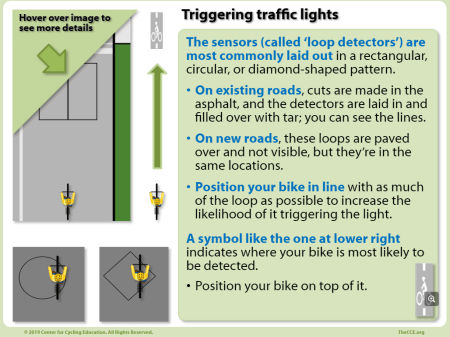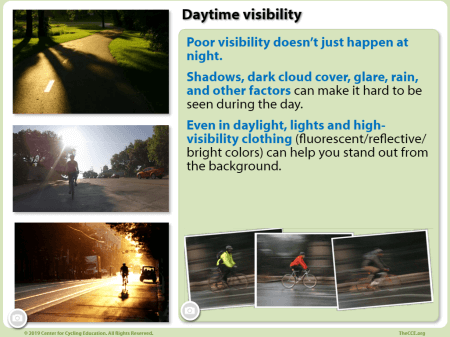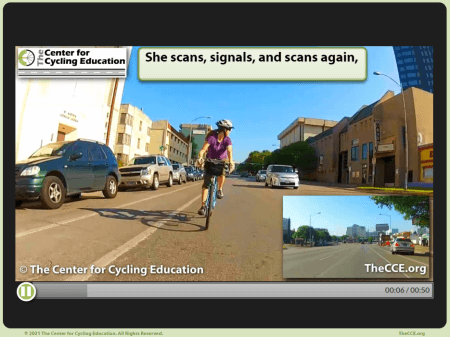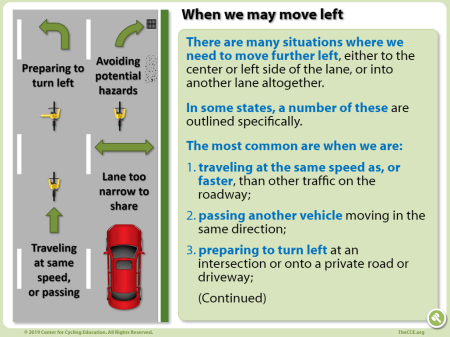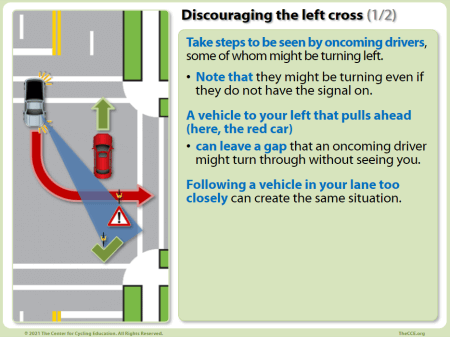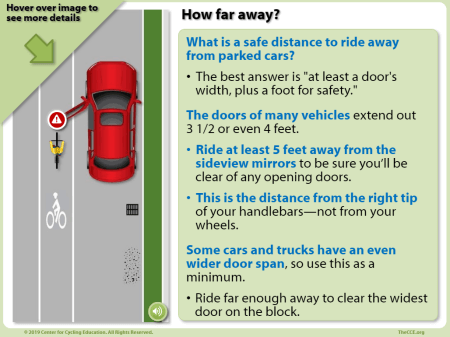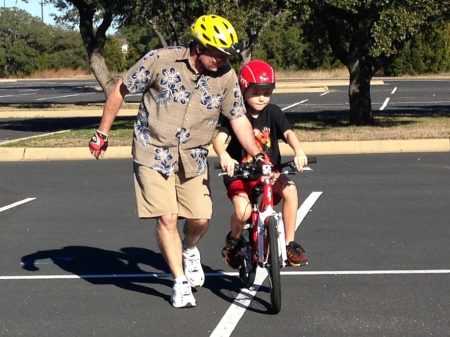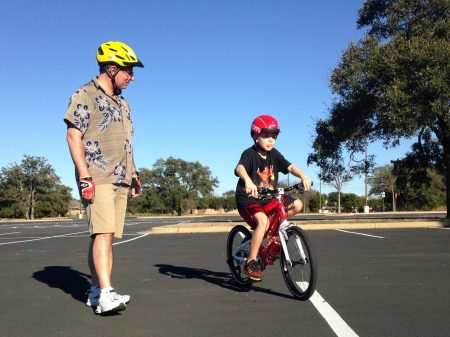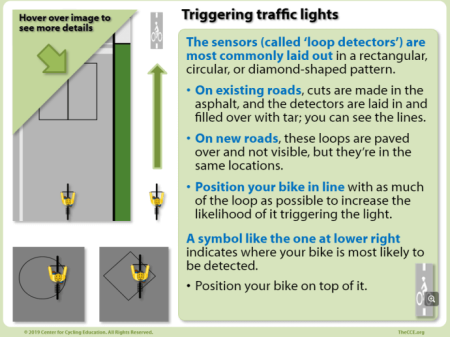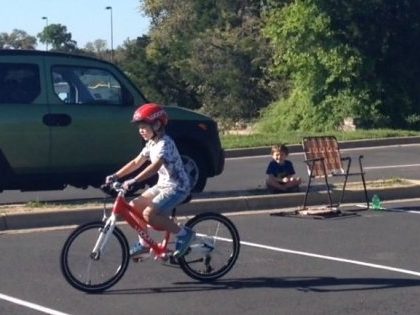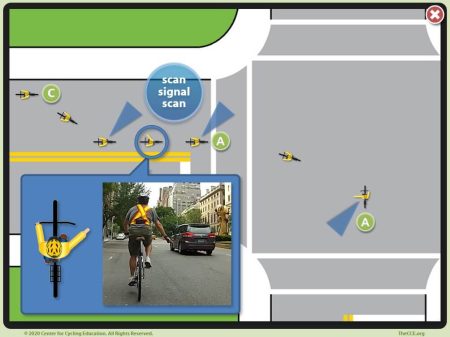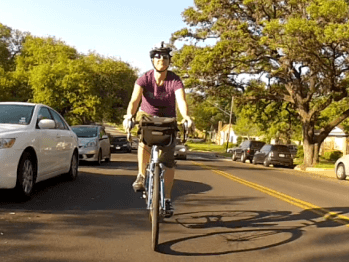There are no federal laws outlining the rules of the road. Instead, each state has its own set of traffic laws. In many cases, these are based at least in part on the Uniform Vehicle Code.
The Revised Code of Washington governs bicycling in the state.
In addition to this, many counties, cities/towns, campuses, & military bases may have their own traffic regulations, usually known as ordinances or codes.
These local regulations may not take away any rights listed in the state traffic laws unless this option is expressly permitted by the state. They also may not permit a person riding a bike to do anything prohibited by state law.
See below for the state laws that apply to riding your bike in Washington.
Cycling Laws » USA » WA – Washington » Revised Code of Washington (RCW)

Rules of the Road
RCW 46.20.500: Special endorsement—Penalties—Exceptions.
(1) No person may drive either a two-wheeled or a three-wheeled motorcycle, or a motor-driven cycle unless such person has a valid driver’s license specially endorsed by the director to enable the holder to drive such vehicles. A person who violates this section commits a traffic infraction and is subject to: (a) The base penalty provided under RCW 46.63.110; and (b) an additional monetary penalty of two hundred fifty dollars, which must be deposited in the motorcycle safety education account under RCW 46.68.065.
(2) However, a person sixteen years of age or older, holding a valid driver’s license of any class issued by the state of the person’s residence, may operate a moped without taking any special examination for the operation of a moped.
(3) No driver’s license is required for operation of an electric-assisted bicycle. Persons under sixteen years of age may not operate a class 3 electric-assisted bicycle.
(4) No driver’s license is required to operate an electric personal assistive mobility device or a power wheelchair.
(5) No driver’s license is required to operate a motorized foot scooter. Motorized foot scooters may not be operated at any time from a half hour after sunset to a half hour before sunrise without reflectors of a type approved by the state patrol. Persons under sixteen years of age may not operate a motorized foot scooter unless provided otherwise by a local jurisdiction. A motorized foot scooter may be operated at a speed of up to fifteen miles per hour on a roadway or bicycle lane, and may be operated on a sidewalk or on pedestrian or bicycle trails if authorized by a local jurisdiction, which shall specify the maximum speed of such sidewalk operation.
(6) A person holding a valid driver’s license may operate a motorcycle as defined under RCW 46.04.330(2) without a motorcycle endorsement.
(7) A person operating a motorcycle with a stabilizing conversion kit must have a valid driver’s license specially endorsed by the director for a three-wheeled motorcycle to enable the holder to operate such a motorcycle.
NOTES: Rules of court: Monetary penalty schedule—IRLJ 6.2.
Reviser’s note: This section was amended by 2019 c 65 § 4 and by 2019 c 170 § 4, each without reference to the other. Both amendments are incorporated in the publication of this section under RCW 1.12.025(2). For rule of construction, see RCW 1.12.025(1).
Chapter 46.37 RCW: VEHICLE LIGHTING AND OTHER EQUIPMENT
RCW 46.37.280: Special restrictions on lamps.
(1) During the times specified in RCW 46.37.020, any lighted lamp or illuminating device upon a motor vehicle, other than head lamps, spot lamps, auxiliary lamps, flashing turn signals, emergency vehicle warning lamps, warning lamps authorized by the state patrol and school bus warning lamps, which projects a beam of light of an intensity greater than three hundred candlepower shall be so directed that no part of the high intensity portion of the beam will strike the level of the roadway on which the vehicle stands at a distance of more than seventy-five feet from the vehicle.
(2) Except as required in RCW 46.37.190 no person shall drive or move any vehicle or equipment upon any highway with any lamp or device thereon displaying a red light visible from directly in front of the center thereof.
(3) Flashing lights are prohibited except as required in RCW 46.37.190, 46.37.200, 46.37.210, 46.37.215, and 46.37.300, warning lamps authorized by the state patrol, and light-emitting diode flashing taillights on bicycles.
RCW 46.37.530: Motorcycles, motor-driven cycles, mopeds, electric-assisted bicycles—Helmets, other equipment—Children—Rules.
(1) It is unlawful:
(a) For any person to operate a motorcycle, moped, or motor-driven cycle not equipped with mirrors on the left and right sides which shall be so located as to give the driver a complete view of the highway for a distance of at least two hundred feet to the rear of the motorcycle, moped, or motor-driven cycle: PROVIDED, That mirrors shall not be required on any motorcycle or motor-driven cycle over twenty-five years old originally manufactured without mirrors and which has been restored to its original condition and which is being ridden to or from or otherwise in conjunction with an antique or classic motorcycle contest, show, or other such assemblage: PROVIDED FURTHER, That no mirror is required on any motorcycle manufactured prior to January 1, 1931;
(b) For any person to operate a motorcycle, moped, or motor-driven cycle which does not have a windshield unless wearing glasses, goggles, or a face shield of a type conforming to rules adopted by the state patrol;
(c) For any person to operate or ride upon a motorcycle, motor-driven cycle, or moped on a state highway, county road, or city street unless wearing upon his or her head a motorcycle helmet except when the vehicle is an antique motor-driven cycle or when the vehicle is equipped with all of the following:
(i) Steering wheel;
(ii) Seat belts that conform to standards prescribed under 49 C.F.R. Part 571; and
(iii) Partially or completely enclosed seating area for the driver and passenger that is certified by the manufacturer as meeting the standards prescribed under 49 C.F.R. Sec. 571.216.
The motorcycle helmet neck or chin strap must be fastened securely while the motorcycle, moped, or motor-driven cycle is in motion. Persons operating electric-assisted bicycles and motorized foot scooters shall comply with all laws and regulations related to the use of bicycle helmets;
(d) For any person to transport a child under the age of five on a motorcycle or motor-driven cycle;
(e) For any person to sell or offer for sale a motorcycle helmet that does not meet the requirements established by this section.
(2) The state patrol may adopt and amend rules concerning standards for glasses, goggles, and face shields.
(3) For purposes of this section, “motorcycle helmet” means a protective covering for the head consisting of a hard outer shell, padding adjacent to and inside the outer shell, and a neck or chin strap type retention system, with the manufacturer’s certification applied in accordance with 49 C.F.R. Sec. 571.218 indicating that the motorcycle helmet meets standards established by the United States department of transportation.
NOTES: Rules of court: Monetary penalty schedule—IRLJ 6.2.
Short title—1990 c 270: See RCW 43.70.440.
Construction—Application of rules—Severability—1987 c 330: See notes following RCW 28B.12.050.
Severability—1982 c 77: See note following RCW 46.20.500.
Severability—1977 ex.s. c 355: See note following RCW 46.37.010.
Maximum height for handlebars: RCW 46.61.611.
Riding on motorcycles: RCW 46.61.610.
RCW 46.37.690: Electric-assisted bicycles—Label—Compliance with equipment and manufacturing requirements—No tampering unless label is replaced—Bicycle and bicycle rider provisions apply.
(1) A manufacturer or distributor of new electric-assisted bicycles, where electric-assisted bicycles are defined in RCW 46.04.169, offered for sale or distribution in Washington state must:
(a) Beginning July 1, 2018, permanently affix, in a prominent location, a label printed in arial font and at least nine-point type that contains the classification number, top assisted speed, and motor wattage;
(b) Comply with the equipment and manufacturing requirements for bicycles adopted by the United States consumer product safety commission.
(2) A person shall not tamper with or modify an electric-assisted bicycle, as defined in RCW 46.04.169, so as to change the speed capability of the electric-assisted bicycle, unless the label in subsection (1)(a) of this section is appropriately replaced.
(3) Except as otherwise provided, an electric-assisted bicycle or a rider of an electric-assisted bicycle is subject to the same provisions of this title as a bicycle or the rider of a bicycle.
Chapter 46.61 RCW: RULES OF THE ROAD
RCW 46.61.126: Pedestrians and bicyclists—Legal duties.
Nothing in RCW 46.61.110, 46.61.120, or 46.61.125 relieves pedestrians and bicyclists of their legal duties while traveling on public highways.
RCW 46.61.160: Restrictions on limited access highway—Use by bicyclists.
The department of transportation may by order, and local authorities may by ordinance or resolution, with respect to any limited access highway under their respective jurisdictions prohibit the use of any such highway by funeral processions, or by parades, pedestrians, bicycles or other nonmotorized traffic, or by any person operating a motor-driven cycle. Bicyclists may use the right shoulder of limited access highways except where prohibited. The department of transportation may by order, and local authorities may by ordinance or resolution, with respect to any limited access highway under their respective jurisdictions prohibit the use of the shoulders of any such highway by bicycles within urban areas or upon other sections of the highway where such use is deemed to be unsafe.
The department of transportation or the local authority adopting any such prohibitory regulation shall erect and maintain official traffic control devices on the limited access roadway on which such regulations are applicable, and when so erected no person may disobey the restrictions stated on such devices.
NOTES: Severability—1975 c 62: See note following RCW 36.75.010.
RCW 46.61.184: Bicycle, moped, or street legal motorcycle at intersection with inoperative vehicle detection device.
Notwithstanding any provision of law to the contrary, the operator of a bicycle, moped, or street legal motorcycle approaching an intersection, including a left turn intersection, that is controlled by a triggered traffic control signal using a vehicle detection device that is inoperative due to the size or composition of the bicycle, moped, or street legal motorcycle shall come to a full and complete stop at the intersection. If the traffic control signal, including the left turn signal, as appropriate, fails to operate after one cycle of the traffic signal, the operator may, after exercising due care, proceed directly through the intersection or proceed to turn left, as appropriate. It is not a defense to a violation of RCW 46.61.050 that the operator of a bicycle, moped, or motorcycle proceeded under the belief that a traffic control signal used a vehicle detection device or was inoperative due to the size or composition of the bicycle, moped, or motorcycle when the signal did not use a vehicle detection device or that any such device was not in fact inoperative due to the size or composition of the bicycle, moped, or motorcycle. For purposes of this section, “bicycle” includes a bicycle, as defined in RCW 46.04.071, and an electric-assisted bicycle, as defined in RCW 46.04.169.
RCW 46.61.190: Vehicle entering stop or yield intersection—Vulnerable users of a public way—Fine.
(1) Preferential right-of-way may be indicated by stop signs or yield signs as authorized in RCW 47.36.110.
(2)(a) Except when directed to proceed by a duly authorized flagger, or a police officer, or a firefighter vested by law with authority to direct, control, or regulate traffic, every driver of a vehicle approaching a stop sign shall stop except as provided in (b) of this subsection at a clearly marked stop line, but if none, before entering a marked crosswalk on the near side of the intersection or, if none, then at the point nearest the intersecting roadway where the driver has a view of approaching traffic on the intersecting roadway before entering the roadway, and after having stopped shall yield the right-of-way to any vehicle in the intersection or approaching on another roadway so closely as to constitute an immediate hazard during the time when such driver is moving across or within the intersection or junction of roadways.
(b)(i) With the exception of (b)(ii) and (iii) of this subsection, a person operating a bicycle approaching a stop sign shall either:
(A) Follow the requirements for approaching a stop sign as specified in (a) of this subsection; or
(B) Follow the requirements for approaching a yield sign as specified in subsection (3) of this section.
(ii) A person operating a bicycle approaching a stop sign located at a highway grade crossing of a railroad must follow the requirements of RCW 46.61.345 [‘All vehicles must stop at certain railroad grade crossings’: See below.]
(iii) A person operating a bicycle approaching a “stop” signal in use by a school bus, as required under RCW 46.37.190, must follow the requirements of RCW 46.61.370.
(3) The driver of a vehicle approaching a yield sign shall in obedience to such sign slow down to a speed reasonable for the existing conditions and if required for safety to stop, shall stop at a clearly marked stop line, but if none, before entering a marked crosswalk on the near side of the intersection or if none, then at the point nearest the intersecting roadway where the driver has a view of approaching traffic on the intersecting roadway before entering the roadway, and then after slowing or stopping, the driver shall yield the right-of-way to any vehicle in the intersection or approaching on another roadway so closely as to constitute an immediate hazard during the time such driver is moving across or within the intersection or junction of roadways: PROVIDED, That if such a driver is involved in a collision with a vehicle in the intersection or junction of roadways, after driving past a yield sign without stopping, such collision shall be deemed prima facie evidence of the driver’s failure to yield right-of-way.
(4)(a) When right-of-way has not been yielded in accordance with this section to a vehicle that is a vulnerable user of a public way, a driver of a motor vehicle found to be in violation of this section must be assessed an additional fine equal to the base penalty assessed under RCW 46.63.110(3). This fine may not be waived, reduced, or suspended, unless the court finds the offender to be indigent, and is not subject to the additional fees and assessments that the base penalty for this violation is subject to under RCW 2.68.040, 3.62.090, and 46.63.110.
(b) For the purposes of this section, “vulnerable user of a public way” has the same meaning as provided in RCW 46.61.526(11)(c).
(5) The additional fine imposed under subsection (4) of this section must be deposited into the vulnerable roadway user education account created in RCW 46.61.145.
NOTES: Rules of court: Monetary penalty schedule—IRLJ 6.2.
RCW 46.61.345: All vehicles must stop at certain railroad grade crossings.
The state department of transportation and local authorities within their respective jurisdictions are authorized to designate particularly dangerous highway grade crossings of railroads and to erect stop signs at those crossings. When such stop signs are erected the driver of any vehicle shall stop within fifty feet but not less than fifteen feet from the nearest rail of the railroad and shall proceed only upon exercising due care.
RCW 46.61.427: Slow-moving vehicle to pull off roadway.
On a two-lane highway where passing is unsafe because of traffic in the opposite direction or other conditions, a slow moving vehicle, behind which five or more vehicles are formed in a line, shall turn off the roadway wherever sufficient area for a safe turn-out exists, in order to permit the vehicles following to proceed. As used in this section a slow moving vehicle is one which is proceeding at a rate of speed less than the normal flow of traffic at the particular time and place.
RCW 46.61.428: Slow-moving vehicle driving on shoulders, when.
(1) The state department of transportation and local authorities are authorized to determine those portions of any two-lane highways under their respective jurisdictions on which drivers of slow-moving vehicles may safely drive onto improved shoulders for the purpose of allowing overtaking vehicles to pass and may by appropriate signs indicate the beginning and end of such zones.
(2) Where signs are in place to define a driving-on-shoulder zone as set forth in subsection (1) of this section, the driver of a slow-moving vehicle may drive onto and along the shoulder within the zone but only for the purpose of allowing overtaking vehicles to pass and then shall return to the roadway.
(3) Signs erected to define a driving-on-shoulder zone take precedence over pavement markings for the purpose of allowing the movements described in subsection (2) of this section.
RCW 46.61.460: Special speed limitation on motor-driven cycle.
No person shall operate any motor-driven cycle at any time mentioned in RCW 46.37.020 at a speed greater than thirty-five miles per hour unless such motor-driven cycle is equipped with a head lamp or lamps which are adequate to reveal a person or vehicle at a distance of three hundred feet ahead.
RCW 46.61.700: Parent or guardian shall not authorize or permit violation by a child or ward.
The parent of any child and the guardian of any ward shall not authorize or knowingly permit any such child or ward to violate any of the provisions of this chapter.
NOTES: Reviser’s note: This section was enacted just before sections about the operation of bicycles and play vehicles and was accordingly so codified in 1965. Other sections enacted later have been codified under the numbers remaining between RCW 46.61.700 and 46.61.750. The section appears in the Uniform Vehicle Code (1962) as part of the first section of Article XII—Operation of Bicycles and Play Vehicles.
Unlawful to allow unauthorized child or ward to drive: RCW 46.20.024.
RCW 46.61.710: Mopeds, EPAMDs, motorized foot scooters, personal delivery devices, electric-assisted bicycles, class 1 electric-assisted bicycles, class 2 electric-assisted bicycles, class 3 electric-assisted bicycles—General requirements and operation.
(1) No person shall operate a moped upon the highways of this state unless the moped has been assigned a moped registration number and displays a moped permit in accordance with RCW 46.16A.405(2).
(2) Notwithstanding any other provision of law, a moped may not be operated on a bicycle path or trail, bikeway, equestrian trail, or hiking or recreational trail.
(3) Operation of a moped, electric personal assistive mobility device, or motorized foot scooter on a fully controlled limited access highway is unlawful. Operation of a personal delivery device on any part of a highway other than a sidewalk or crosswalk is unlawful, except as provided in RCW 46.61.240(2) and 46.61.250(2). Operation of a moped on a sidewalk is unlawful. Operation of a motorized foot scooter or class 3 electric-assisted bicycle on a sidewalk is unlawful, unless there is no alternative for a motorized foot scooter or a class 3 electric-assisted bicycle to travel over a sidewalk as part of a bicycle or pedestrian path, or if authorized by local ordinance, as provided in RCW 46.61.715.
(4) Removal of any muffling device or pollution control device from a moped is unlawful.
(5) Subsections (1), (2), and (4) of this section do not apply to electric-assisted bicycles.
(6) Electric-assisted bicycles and motorized foot scooters may have access to highways of the state and may be parked to the same extent as bicycles, subject to RCW 46.61.160.
(7) Subject to subsection (10) of this section, class 1 and class 2 electric-assisted bicycles and motorized foot scooters may be operated on a shared-use path or any part of a highway designated for the use of bicycles, but local jurisdictions or state agencies may restrict or otherwise limit the access of electric-assisted bicycles and motorized foot scooters, and local jurisdictions or state agencies may regulate the use of class 1 and class 2 electric-assisted bicycles and motorized foot scooters on facilities, properties, and rights-of-way under their jurisdiction and control. Local regulation of the operation of class 1 or class 2 electric-assisted bicycles, upon a shared use path designated for the use of bicycles that crosses jurisdictional boundaries of two or more local jurisdictions, must be consistent for the entire shared use path in order for the local regulation to be enforceable; however, this does not apply to local regulations of a shared use path in effect as of January 1, 2018.
(8) Class 3 electric-assisted bicycles may be operated on facilities that are within or adjacent to a highway. Class 3 electric-assisted bicycles may not be operated on a shared-use path, except where local jurisdictions may allow the use of class 3 electric-assisted bicycles. State agencies or local jurisdictions may regulate the use of class 3 electric-assisted bicycles on facilities and properties under their jurisdiction and control. Local regulation of the operation of class 3 electric-assisted bicycles, upon a shared use path designated for the use of bicycles that crosses jurisdictional boundaries of two or more local jurisdictions, must be consistent for the entire shared use path in order for the local regulation to be enforceable; however, this does not apply to local regulations of a shared use path in effect as of January 1, 2018.
(9) Except as otherwise provided in this section, an individual shall not operate an electric-assisted bicycle or motorized foot scooter on a trail that is specifically designated as nonmotorized and that has a natural surface tread that is made by clearing and grading the native soil with no added surfacing materials. A local authority or agency of this state having jurisdiction over a trail described in this subsection may allow the operation of an electric-assisted bicycle or motorized foot scooter on that trail.
(10) Subsections (1) and (4) of this section do not apply to motorized foot scooters. Subsection (2) of this section applies to motorized foot scooters when the bicycle path, trail, bikeway, equestrian trail, or hiking or recreational trail was built or is maintained with federal highway transportation funds. Additionally, any new trail or bicycle path or readily identifiable existing trail or bicycle path not built or maintained with federal highway transportation funds may be used by persons operating motorized foot scooters only when signed to allow motorized foot scooter use.
(11) A person operating an electric personal assistive mobility device (EPAMD) shall obey all speed limits and shall yield the right-of-way to pedestrians and human-powered devices at all times. An operator must also give an audible signal before overtaking and passing a pedestrian. Except for the limitations of this subsection, persons operating an EPAMD have all the rights and duties of a pedestrian.
(12) The use of an EPAMD may be regulated in the following circumstances:
(a) A municipality and the department of transportation may prohibit the operation of an EPAMD on public highways within their respective jurisdictions where the speed limit is greater than twenty-five miles per hour;
(b) A municipality may restrict the speed of an EPAMD in locations with congested pedestrian or nonmotorized traffic and where there is significant speed differential between pedestrians or nonmotorized traffic and EPAMD operators. The areas in this subsection must be designated by the city engineer or designee of the municipality. Municipalities shall not restrict the speed of an EPAMD in the entire community or in areas in which there is infrequent pedestrian traffic;
(c) A state agency or local government may regulate the operation of an EPAMD within the boundaries of any area used for recreation, open space, habitat, trails, or conservation purposes.
NOTES: Reviser’s note: This section was amended by 2019 c 170 § 3 and by 2019 c 214 § 19, each without reference to the other. Both amendments are incorporated in the publication of this section under RCW 1.12.025(2). For rule of construction, see RCW 1.12.025(1).
RCW 46.61.750: Effect of regulations—Penalty.
(1) It is a traffic infraction for any person to do any act forbidden or fail to perform any act required in RCW 46.61.750 through 46.61.780.
(2) These regulations applicable to bicycles apply whenever a bicycle is operated upon any highway or upon any bicycle path, subject to those exceptions stated herein.
NOTES: Rules of court: Monetary penalty schedule—IRLJ 6.2.
Effective date—Severability—1979 ex.s. c 136: See notes following RCW 46.63.010.
Bicycle awareness program: RCW 43.43.390.
“Bicycle” defined: RCW 46.04.071.
RCW 46.61.755: Traffic laws apply to persons riding bicycles.
(1) Every person riding a bicycle upon a roadway shall be granted all of the rights and shall be subject to all of the duties applicable to the driver of a vehicle by this chapter, except as to special regulations in RCW 46.61.750 through 46.61.780, except as provided in RCW 46.61.190, and except as to those provisions of this chapter which by their nature can have no application.
(2) Every person riding a bicycle upon a sidewalk or crosswalk must be granted all of the rights and is subject to all of the duties applicable to a pedestrian by this chapter.
NOTES: Rules of court: Monetary penalty schedule—IRLJ 6.2.
RCW 46.61.758: Hand signals.
All hand signals required of persons operating bicycles shall be given in the following manner:
(1) Left turn. Left hand and arm extended horizontally beyond the side of the bicycle;
(2) Right turn. Left hand and arm extended upward beyond the side of the bicycle, or right hand and arm extended horizontally to the right side of the bicycle;
(3) Stop or decrease speed. Left hand and arm extended downward beyond the side of the bicycle.
The hand signals required by this section shall be given before initiation of a turn.
RCW 46.61.760: Riding on bicycles.
(1) A person propelling a bicycle shall not ride other than upon or astride a permanent and regular seat attached thereto.
(2) No bicycle shall be used to carry more persons at one time than the number for which it is designed and equipped.
RCW 46.61.765: Clinging to vehicles.
No person riding upon any bicycle, coaster, roller skates, sled, or toy vehicle shall attach the same or himself or herself to any vehicle upon a roadway.
NOTES: Rules of court: Monetary penalty schedule—IRLJ 6.2.
RCW 46.61.770: Riding on roadways and bicycle paths.
(1) Every person operating a bicycle upon a roadway at a rate of speed less than the normal flow of traffic at the particular time and place shall ride as near to the right side of the right through lane as is safe except:
(a) While preparing to make or while making turning movements at an intersection or into a private road or driveway;
(b) When approaching an intersection where right turns are permitted and there is a dedicated right turn lane, in which case a person may operate a bicycle in this lane even if the operator does not intend to turn right;
(c) While overtaking and passing another bicycle or vehicle proceeding in the same direction; and
(d) When reasonably necessary to avoid unsafe conditions including, but not limited to, fixed or moving objects, parked or moving vehicles, bicyclists, pedestrians, animals, and surface hazards.
(2) A person operating a bicycle upon a roadway or highway other than a limited access highway, which roadway or highway carries traffic in one direction only and has two or more marked traffic lanes, may ride as near to the left side of the left through lane as is safe.
(3) A person operating a bicycle upon a roadway may use the shoulder of the roadway or any specially designated bicycle lane.
(4) When the operator of a bicycle is using the travel lane of a roadway with only one lane for traffic moving in the direction of travel and it is wide enough for a bicyclist and a vehicle to travel safely side-by-side within it, the bicycle operator shall operate far enough to the right to facilitate the movement of an overtaking vehicle unless other conditions make it unsafe to do so or unless the bicyclist is preparing to make a turning movement or while making a turning movement.
(5) Persons riding bicycles upon a roadway shall not ride more than two abreast except on paths or parts of roadways set aside for the exclusive use of bicycles.
NOTES: Rules of court: Monetary penalty schedule—IRLJ 6.2.
Finding—Intent—Effective date—2019 c 403: See notes following RCW 46.04.071.
Use of bicycles on limited access highways: RCW 46.61.160.
RCW 46.61.775: Carrying articles.
No person operating a bicycle shall carry any package, bundle or article which prevents the driver from keeping at least one hand upon the handlebars.
NOTES: Rules of court: Monetary penalty schedule—IRLJ 6.2.
RCW 46.61.780: Lamps and other equipment on bicycles.
(1) Every bicycle when in use during the hours of darkness as defined in RCW 46.37.020 shall be equipped with a lamp on the front which shall emit a white light visible from a distance of at least five hundred feet to the front and with a red reflector on the rear of a type approved by the state patrol which shall be visible from all distances up to six hundred feet to the rear when directly in front of lawful lower beams of head lamps on a motor vehicle. A lamp emitting a red light visible from a distance of five hundred feet to the rear may be used in addition to the red reflector. A light-emitting diode flashing taillight visible from a distance of five hundred feet to the rear may also be used in addition to the red reflector.
(2) Every bicycle shall be equipped with a brake which will enable the operator to make the braked wheels skid on dry, level, clean pavement.
NOTES: Rules of court: Monetary penalty schedule—IRLJ 6.2.
Short title—1998 c 165: See note following RCW 43.59.010.
Construction—Application of rules—Severability—1987 c 330: See notes following RCW 28B.12.050.
Severability—1975 c 62: See note following RCW 36.75.010.
RCW 46.61.790: Intoxicated bicyclists.
(1) A law enforcement officer may offer to transport a bicycle rider who appears to be under the influence of alcohol or any drug and who is walking or moving along or within the right-of-way of a public roadway, unless the bicycle rider is to be taken into protective custody under *RCW 70.96A.120. The law enforcement officer offering to transport an intoxicated bicycle rider under this section shall:
(a) Transport the intoxicated bicycle rider to a safe place; or
(b) Release the intoxicated bicycle rider to a competent person.
(2) The law enforcement officer shall not provide the assistance offered if the bicycle rider refuses to accept it. No suit or action may be commenced or prosecuted against the law enforcement officer, law enforcement agency, the state of Washington, or any political subdivision of the state for any act resulting from the refusal of the bicycle rider to accept this assistance.
(3) The law enforcement officer may impound the bicycle operated by an intoxicated bicycle rider if the officer determines that impoundment is necessary to reduce a threat to public safety, and there are no reasonable alternatives to impoundment. The bicyclist will be given a written notice of when and where the impounded bicycle may be reclaimed. The bicycle may be reclaimed by the bicycle rider when the bicycle rider no longer appears to be intoxicated, or by an individual who can establish ownership of the bicycle. The bicycle must be returned without payment of a fee. If the bicycle is not reclaimed within thirty days, it will be subject to sale or disposal consistent with agency procedures.
Definitions
RCW 46.04.071: ‘Bicycle’
“Bicycle” means every device propelled solely by human power, or an electric-assisted bicycle as defined in RCW 46.04.169, upon which a person or persons may ride, having two tandem wheels either of which is sixteen inches or more in diameter, or three wheels, any one of which is twenty inches or more in diameter.
NOTES: Finding—Intent—2019 c 403: “The legislature finds that a number of the collision types that have resulted in a high number of serious injuries and deaths of vulnerable roadway users can be associated with certain types of traffic infractions. To address the heightened risk to vulnerable roadway users when violations of these traffic infractions occur, the legislature intends to: (1) Introduce an additional fine as a penalty for drivers who commit these violations against a vulnerable roadway user; (2) modify when certain vulnerable roadway users may be passed by motor vehicles; and (3) clarify when and how pedestrians and bicyclists may use the roadway. To increase enforcement of all traffic infractions and offenses committed against vulnerable roadway users, the legislature intends for revenue that is collected from the new fine to be dedicated to the education of law enforcement officers, prosecutors, and judges about opportunities for the enforcement of traffic violations committed against vulnerable roadway users, with any remaining funds to be used to increase awareness by the public of the risks and penalties associated with these traffic violations. The goals of this act are to achieve a reduction in the frequency with which drivers violate traffic laws that endanger vulnerable roadway users and to encourage safe sharing of the roadway by drivers, bicyclists, pedestrians, and other vulnerable roadway users.” [ 2019 c 403 § 1.]
RCW 46.04.169: ‘Electric-assisted bicycle—Class 1 electric-assisted bicycle—Class 2 electric-assisted bicycle—Class 3 electric-assisted bicycle’
“Electric-assisted bicycle” means a bicycle with two or three wheels, a saddle, fully operative pedals for human propulsion, and an electric motor. The electric-assisted bicycle’s electric motor must have a power output of no more than seven hundred fifty watts. The electric-assisted bicycle must meet the requirements of one of the following three classifications:
(1) “Class 1 electric-assisted bicycle” means an electric-assisted bicycle in which the motor provides assistance only when the rider is pedaling and ceases to provide assistance when the bicycle reaches the speed of twenty miles per hour;
(2) “Class 2 electric-assisted bicycle” means an electric-assisted bicycle in which the motor may be used exclusively to propel the bicycle and is not capable of providing assistance when the bicycle reaches the speed of twenty miles per hour; or
(3) “Class 3 electric-assisted bicycle” means an electric-assisted bicycle in which the motor provides assistance only when the rider is pedaling and ceases to provide assistance when the bicycle reaches the speed of twenty-eight miles per hour and is equipped with a speedometer.
RCW 46.04.197: Highway.
Highway means the entire width between the boundary lines of every way publicly maintained when any part thereof is open to the use of the public for purposes of vehicular travel.
RCW 46.04.220: ‘Intersection area’
(1) “Intersection area” means the area embraced within the prolongation or connection of the lateral curb lines, or, if none then the lateral boundary lines of the roadways of two or more highways which join one another at, or approximately at, right angles, or the area within which vehicles traveling upon different highways joining at any other angle may come in conflict.
(2) Where a highway includes two roadways thirty feet or more apart, then every crossing of each roadway of such divided highway by an intersecting highway shall be regarded as a separate intersection. In the event such intersecting highway also includes two roadways thirty feet or more apart, then every crossing of two roadways of such highways shall be regarded as a separate intersection.
(3) The junction of an alley with a street or highway shall not constitute an intersection.
RCW 46.04.304: ‘Moped’
“Moped” means a motorized device designed to travel with not more than three wheels in contact with the ground and having an electric or a liquid fuel motor with a cylinder displacement not exceeding fifty cubic centimeters which produces no more than two gross brake horsepower (developed by a prime mover, as measured by a brake applied to the driving shaft) that is capable of propelling the device at not more than thirty miles per hour on level ground.
NOTES: Construction—Application of rules—Severability—1987 c 330: See notes following RCW 28B.12.050.
RCW 46.04.400: ‘Pedestrian’
“Pedestrian” means any person who is afoot or who is using a wheelchair, a power wheelchair, or a means of conveyance propelled by human power other than a bicycle.
RCW 46.04.540: ‘Sidewalk’
“Sidewalk” means that property between the curb lines or the lateral lines of a roadway and the adjacent property, set aside and intended for the use of pedestrians or such portion of private property parallel and in proximity to a public highway and dedicated to use by pedestrians.
RCW 46.04.565: ‘Stop’
“Stop” when required means complete cessation from movement.
NOTES:
Severability—1975 c 62: See note following RCW 36.75.010.
RCW 46.04.566: ‘Stop or stopping’
“Stop or stopping” when prohibited means any halting even momentarily of a vehicle, whether occupied or not, except when necessary to avoid conflict with other traffic or in compliance with the directions of a police officer or traffic control sign or signal.
NOTES:
Severability—1975 c 62: See note following RCW 36.75.010.
RCW 46.04.590: ‘Traffic’
“Traffic” includes pedestrians, ridden or herded animals, vehicles, streetcars, and other conveyances either singly or together, while using any public highways for purposes of travel.
RCW 46.04.620: ‘Trailer’
“Trailer” includes every vehicle without motive power designed for being drawn by or used in conjunction with a motor vehicle constructed so that no appreciable part of its weight rests upon or is carried by such motor vehicle, but does not include a municipal transit vehicle, or any portion thereof. “Trailer” does not include a cargo extension.
RCW 46.04.670: ‘Vehicle’ (as amended by 2019 c 170). [NOTE: SEE NEWER WORDING BELOW] “Vehicle” includes every device capable of being moved upon a public highway and in, upon, or by which any persons or property is or may be transported or drawn upon a public highway, including bicycles. “Vehicle” does not include power wheelchairs or devices other than bicycles moved by human or animal power or used exclusively upon stationary rails or tracks. Mopeds are not considered vehicles or motor vehicles for the purposes of chapter 46.70 [dealers and manufacturers] RCW. Bicycles and motorized foot scooters are not considered vehicles for the purposes of chapter 46.12 [certificates of title], 46.16A [registration], or 46.70 [dealers and manufacturers] RCW or RCW 82.12.045. Electric personal assistive mobility devices and motorized foot scooters are not considered vehicles or motor vehicles for the purposes of chapter 46.12 [certificates of title], 46.16A [registration], 46.29 [financial responsibility], 46.37 [vehicle lighting and other equipment], or 46.70 [dealers and manufacturers] RCW. A golf cart is not considered a vehicle, except for the purposes of chapter 46.61 [rules of the road] RCW.
RCW 46.04.670: ‘Vehicle’ (as amended by 2019 c 214).
(1) “Vehicle” ((includes every))means a device capable of being moved upon a public highway and in, upon, or by which any persons or property is or may be transported or drawn upon a public highway((, including bicycles)).
(2) “Vehicle” ((does not include))excludes:
(a) A power wheelchair((s)) or device((s)) other than a bicycle((s)) moved by human or animal power or used exclusively upon stationary rails or tracks((. Mopeds are not considered vehicles or motor vehicles));
(b) A moped, for the purposes of chapter 46.70 [dealers and manufacturers] RCW((. Bicycles are not considered vehicles));
(c) A bicycle, for the purposes of chapter 46.12 [certificates of title], 46.16A [registration], or 46.70 [dealers and manufacturers] RCW, or for RCW 82.12.045 [collection of tax on vehicles] ((.));
(d) An electric personal assistive mobility device((s are not considered vehicles or motor vehicles)), for the purposes of chapter 46.12 [certificates of title], 46.16A [registration], 46.29 [financial responsibility], 46.37 [vehicle lighting and other equipment], or 46.70 [dealers and manufacturers] RCW((.));
(e) A golf cart ((is not considered a vehicle)), except for the purposes of chapter 46.61 [rules of the road] RCW; and
(f) A personal delivery device as defined in RCW 46.75.010, except for the purposes of chapter 46.61 RCW.
NOTES: Reviser’s note: RCW 46.04.670 was amended twice during the 2019 legislative session, each without reference to the other. For rule of construction concerning sections amended more than once during the same legislative session, see RCW 1.12.025.
